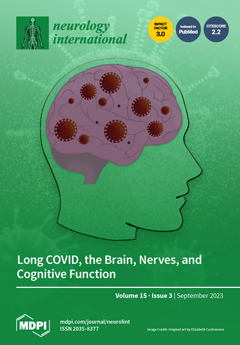Alzheimer’s disease (AD) is the most prevalent neurodegenerative disease of old age. Accumulation of β-amyloid peptide (Aβ) and mitochondrial dysfunction results in chronic microglial activation, which enhances neuroinflammation and promotes neurodegeneration. Microglia are resident macrophages of the brain and spinal cord which play an important role in maintaining brain homeostasis through a variety of phenotypes, including the pro-inflammatory phenotype and anti-inflammatory phenotypes. However, persistently activated microglial cells generate reactive species and neurotoxic mediators. Therefore, inhibitors of microglial activation are seen to have promise in AD control. The modified TPP/MoS
2 QD blend is a mitochondrion-targeted nanomaterial that exhibits cytoprotective activities and antioxidant properties through scavenging free radicals. In the present study, the cell viability and cytotoxicity of the DSPE-PEG-TPP/MoS
2 QD blend on microglial cells stimulated by Aβ were investigated. The levels of reactive oxygen species (ROS) and mitochondrial membrane potential (MMP) were also assessed. In addition, pro-inflammatory and anti-inflammatory cytokines, such as tumor necrosis factor α (TNF-α), interleukin-6 (IL-6), interleukin-1β (IL-1β), transforming growth factor beta (TGF-β), inducible nitric oxide synthase (iNOS) and arginase-1 (Arg-I) were measured in the presence or absence of the DSPE-PEG-TPP/MoS
2 QD blend on an immortalized microglia cells activated by accumulation of Aβ. We found that the DSPE-PEG-TPP/MoS
2 QD blend was biocompatible and nontoxic at specific concentrations. Furthermore, the modified TPP/MoS
2 QD blend significantly reduced the release of free radicals and improved the mitochondrial function through the upregulation of MMP in a dose-dependent manner on microglial cells treated with Aβ. In addition, pre-treatment of microglia with the DSPE-PEG-TPP/MoS
2 QD blend at concentrations of 25 and 50 μg/mL prior to Aβ stimulation significantly inhibited the release and expression of pro-inflammatory cytokines, such as IL-1β, IL-6, TNF-α, and iNOS. Nevertheless, the anti-inflammatory cytokines TGF-β and Arg-I were activated. These findings suggest that the modified TPP/MoS
2 QD blend reduced oxidative stress, inflammation and improved the mitochondrial function in the immortalized microglial cells (IMG) activated by Aβ. Overall, our research shows that the DSPE-PEG-TPP/MoS
2 QD blend has therapeutic promise for managing AD and can impact microglia polarization.
Full article






